
The St. John's Church at Creagerstown Historic District is a national historic district located at Creagerstown, Frederick County, Maryland The district encompasses four contributing buildings and one contributing site, namely:

The Banneker-Douglass Museum, formerly known as Mt. Moriah African Methodist Episcopal Church, is a historic church at Annapolis, Anne Arundel County, Maryland. It was constructed in 1875 and remodeled in 1896. It is a 2+1⁄2-story, gable-front brick church executed in the Gothic Revival style. It served as the meeting hall for the First African Methodist Episcopal Church, originally formed in the 1790s, for nearly 100 years. It was leased to the Maryland Commission on African-American History and Culture, becoming the state's official museum for African-American history and culture. In 1984, a 2+1⁄2-story addition was added when the building opened as the Banneker-Douglass Museum.

Schifferstadt, Also known as Scheifferstadt, is the oldest standing house in Frederick, Maryland. Built in 1758, it is one of the nation's finest examples of German-Georgian colonial architecture. It was designated a National Historic Landmark in 2016.

The Buckingham House and Industrial School Complex is a historic trade school complex located near Buckeystown, Frederick County, Maryland. It consists of thirteen buildings associated with a trade school for boys from poor families that operated from 1898 to 1944. The complex centers on a 3-story dormitory building built for the school, but also includes the late 18th-century Federal style Buckingham House. The surrounding farm was, uniquely for the area, irrigated. Bordering the Monocacy River, the grounds include several significant late Woodland period archeological sites.

The Douglass Summer House is a historic home at Highland Beach, Anne Arundel County, Maryland, United States. It was built in 1894–95, is one of the first built in the small community of Highland Beach and is the oldest structure remaining at that place. The house was built in 1894-95 by Major Charles Douglass, son of Frederick Douglass (1818-1895). It is a 2+1⁄2-story Queen Anne style frame dwelling with a one-story wraparound porch and a corner tower. A meticulous renovation in 1987 by architect Charles Bohl maintained a majority of the original interior and exterior fabric of the building.
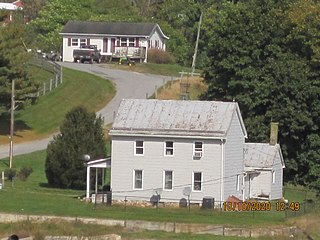
The Drummine Farm is a historic home and farm complex located at New Market, Frederick County, Maryland, United States. The main house was constructed about 1790 and is a 2+1⁄2-story structure of uncoursed fieldstone. The house retains Georgian stylistic influences in exterior and interior decorative detailing. The farm complex structures include a stone tenant house dated 1816, and four additional fieldstone buildings from the early 19th century: a smokehouse, a water storage house, a garden outhouse, and a large bank barn. Wooden farm buildings include a calf shed and a wagon shed with corn cribs from the late 19th century, a dairy barn with three cement stave silos from the 1930s, several sheds and garages, and a large pole barn.
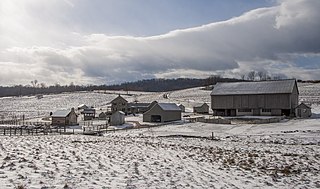
Peter of P. Grossnickel Farm is a historic home and farm complex located at Myersville, Maryland, Frederick County. It consists of a mid-19th-century, Greek Revival farmhouse and 13 related buildings and structures. The house is a 2+1⁄2-story stone center-passage house on a limestone foundation, with a 1+1⁄2-story kitchen wing and 18-inch-thick (460 mm) walls. The house was built between 1840 and 1850. Also on the property is an 1881 tenant house with corresponding barn, spring house, and washhouse / privy; an 1884–1897 bank barn; a pre-1830 granary; a 19th-century wood shed; late-19th-century hog pen / chicken house; a pre-1830 beehive oven; a late-19th-century smokehouse; a spring house with a Late Victorian cottage addition; and early-20th-century concrete block milk house; and a log summer kitchen of unknown date. The Grossnickel family was a German American family who were instrumental in the establishment of the Grossnickel Church of the Brethren.

Harris Farm is a historic home and farm complex located at Walkersville, Frederick County, Maryland, United States. The main house was built in 1855, and is a three-story center plan house in predominantly late Greek Revival syle, with some Italianate elements. The agricultural complex consists of a bank barn with an attached granary; a second frame barn that shares an animal yard with the bank barn; a row of frame outbuildings including a converted garage, a workshop, and a chicken house. There is also a drive-through double corn crib; and a frame pig pen from 1914. The 20th-century buildings consist of a frame poultry house, a dairy barn with milk house and two silos, and an octagonal chicken coop. A lime kiln is located on the edge of the property. The property is preserved as part of the Walkersville Heritage Farm Park.
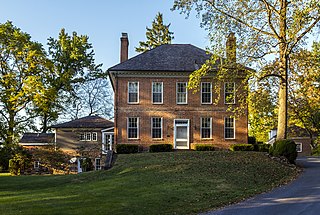
Woods Mill Farm is a historic home and farm complex located at Woodsboro, Frederick County, Maryland. It includes the Colonel Joseph Wood House and associated buildings. The house is an unusual example of an 18th-century brick, Georgian style manor house, built about 1770. It is a two-story brick dwelling with a hipped roof and inside end chimneys. The property also includes two distinctive outbuildings: a two-story, two-room stone and brick smokehouse with a gable roof and a brick end barn built about 1830. The original owner of this property was Col. Joseph Wood, founder of Woodsberry.

The Abraham Jones House is a historic home located at Libertytown, Frederick County, Maryland, United States. It is a 2+1⁄2-story, Flemish bond brick house attached to a later frame structure. Roof features include low "parapets" formed by the extension of the gable walls and at each end of the roof ridge are single flush gable chimneys. The main entrance door is an example of Federal period craftsmanship and design. It is one of the finest Federal houses in Maryland.
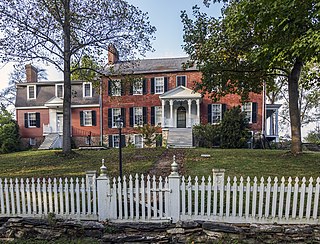
Hopewell is a set of historic homes and farm complexes located at Union Bridge, Carroll County, Maryland, United States. It consists of four related groupings of 19th century farm buildings. The Hopewell complex consists of two historic farms: Hopewell and the smaller F.R. Shriner Farm.

The Amelung House and Glassworks is a historic home located at Urbana, Frederick County, Maryland, United States. It is a two-story, late-Georgian brick home on a stone foundation built about 1785. The property once had the New Bremen glassworks built by Johann Friedrich Amelung after he came to Maryland in 1784; no above-ground remains of the factory remain. Fine examples of New Bremen glass work may be seen at the Metropolitan Museum of Art in New York City; the Corning Museum of Glass in Corning, New York; and Winterthur Museum in Winterthur, Delaware.

The Victor Cullen Center, Old Administration Building is a historic building located at Sabillasville, Frederick County, Maryland, United States. It is a 2+1⁄2-story, stone and frame Colonial Revival style structure located on a hillside with four stone chimneys, two on each gable end. The building was built originally to house the Maryland Tuberculosis Sanitorium, the first state sponsored institution of its type in Maryland. It was designed by the architectural firm Wyatt & Nolting.
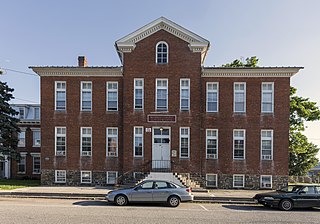
St. Euphemia's School and Sisters' House is a historic school building and convent located at Emmitsburg, Frederick County, Maryland. It is a late-19th century school complex that consists of two attached brick buildings: a two and half story school building built about 1890, and a house that was used as a convent and built about 1860.
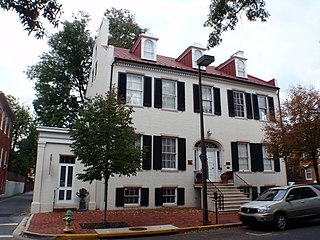
Loats Female Orphan Asylum of Frederick City is a historic home and former orphanage building located at Frederick, Frederick County, Maryland.

The New Market Historic District is a national historic district in New Market, Frederick County, Maryland. The district encompasses the town located along what was originally the National Pike. About 90 percent of the buildings in the historic district date from the 19th century and include Federal-style buildings and Greek Revival buildings, with a number of Victorian buildings, a larger example being the Ramsburg House.

Creagerstown is an unincorporated community in Frederick County, Maryland, United States. It is playfully known by its residents as "4 miles from everywhere" because of its situation at 4 miles (6.4 km) from Thurmont, Woodsboro, Rocky Ridge, and Lewistown.

Sabillasville is an unincorporated community and census-designated place in Frederick County, Maryland, United States. As of the 2010 census it had a population of 354.

The Cullen Homestead Historic District encompasses a cluster of properties associated with the Cullen family in rural Somerset County, Maryland. Located in the center of Hopewell, just northeast of Crisfield, the district has three main features. The first is, known as the Cullen Homestead, is a c. 1820 Federal style wood frame dwelling. The building has retained much of its interior period woodwork, despite being added to and altered over the years, and has retained its original board sheathing under modern aluminum siding. The second house in the district is a later 19th century house built by Jacob Hoke Cullen in 1880. The oldest part of the house is a T-shaped portion, which was roughly mirrored by a later addition around 1910, giving the house its present H shape. This house has also retained interior and some exterior finish work. The third element of the district is the family cemetery.
Cullen House is a grand estate house in the coastal town of Cullen in Moray, Scotland.






















